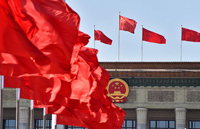Reforms move forward to cut waste
China is making progress against wasteful government spending as it overhauls a rigid fiscal management system tied to GDP and revenue growth, Finance Minister Lou Jiwei said on Sunday.
The reforms are part of a broader effort that began in 2013 to modernize the country's budgeting processes.
One of the efforts highlighted by Lou is the reform of the GDP- and revenue-pegged fiscal expenditure regime, under which spending in priority sectors, such as education and technology, is pegged to growth in revenue.
In 2012 before the reforms began to unfold, 48 percent of government expenditures, or spending in seven categories, were pegged to GDP and revenue growth, Lou said. For example, education spending should increase in line with revenue growth to keep it above 4 percent of a locality's GDP.
This approach gave little wiggle room for flexibility in accordance with local realities, Lou said. For instance, to keep education expenditures at 4 percent of GDP, schools in Beijing and Shanghai have to replace their old desks with new ones every three to four years, even though a desk is typically expected to have a life span of five years. In poorer regions, by contrast, education budgets are insufficient because of static GDP and revenue growth.
In Haidian, an urban district of Beijing, agricultural expenditures must be accelerated to catch up with GDP growth, despite the fact that it has a tiny agriculture sector, Lou said.
The major defect of the system is that it contradicts the "countercyclical" principle, which stresses less spending when GDP expands rapidly and stronger spending when the economy is weak; and it also contradicts the "performance-based" principle under which local governments get funding regardless of how effectively they spent money last year, Lou said.
"Usage of funds is inefficient," he said. "Money can't be used up in some sectors, while those that badly need money can't get it."
China's budgetary system is also progressing in the reform of transfer payments, according to Lou. China has an enormous transfer payment system and the central government allocates hefty funds from well-off regions to backward regions. But the system has been criticized as inefficient, discretionary and susceptible to corruption — especially so-called special transfers.
"The number of special transfer payment items has been slashed to 94 this year from 260 in 2013," Lou said.
General transfer payments — which are more rule-based — as a proportion of total outlays have been increased to 60.5 percent this year from 56.7 percent in 2013, "and there is room for further cut", he said.
Lou also vowed that China would implement a value-added tax reform in all remaining sectors before May 1 in an effort to cut the corporate tax burden. The current reform, he stressed, is still in its pilot phase and will be finalized when the VAT law is passed by the national legislature.


















